Day 98 (January 21, 2013)
Aguas Caliente, Peru to Machu Picchu, Peru
Day's Bus Ride: 5 Miles
We woke up at 4:30 AM to the sound of rain. That is not a good way to start off a visit to Machu Picchu. Actually, Mike was out the door by 4:30; I got up and took my time. By the time I arrived at the bus station, Mike was standing there first in line drinking coffee. It pays to have somebody who's willing to take one for the team!
From Aguas Calientes, there are two ways to get to the top of the hill to see the ruins: walk or take a bus. Initially we had been planning on hiking so that we could be up at the gate when the ruins opened and hopefully snag an entrance ticket to Wayna Picchu, the steep mountain overlooking the north side of Machu Picchu. Unfortunately, we found out last night that the entrance tickets to Waynu Picchu are now sold in advance and there weren't any available for the next week or so. Thanks for nothing Lonely Planet.
In any event, since we weren't in any hurry to get into Wayna Picchu, we took the first bus at 5:30 AM and were at the gates when they opened at 6:00 AM. Unfortunately, it was still foggy and raining hard. We splurged and hired a "guia" (guide) for 60 Soles each and then entered the park. We soon emerged above the ruins and beheld this:
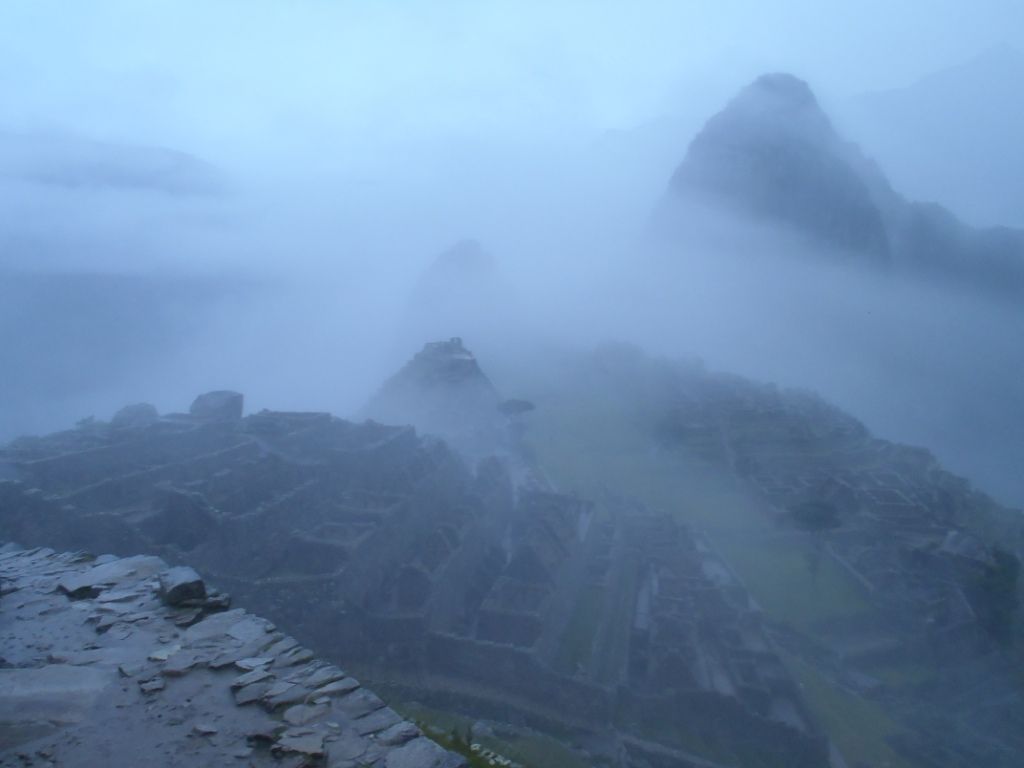
Everything was totally socked in! It was very disappointing, especially after spending so much time and money (despite doing it the cheaper way) to get to this point. Our guide reassured us that the rain would stop soon, and he was right. Little by little, the fog began to clear and the rain began to abate.
Not knowing if the weather might move back in before we got another chance to get pictures, I got my Machu Picchu picture in at the iconic overlook.

The one really nice thing about the rain was that it drove most of the tourists away and for the first part of our tour, we had the place mostly to ourselves.
Leaving the overlook, we descended into the city by the southern gate.
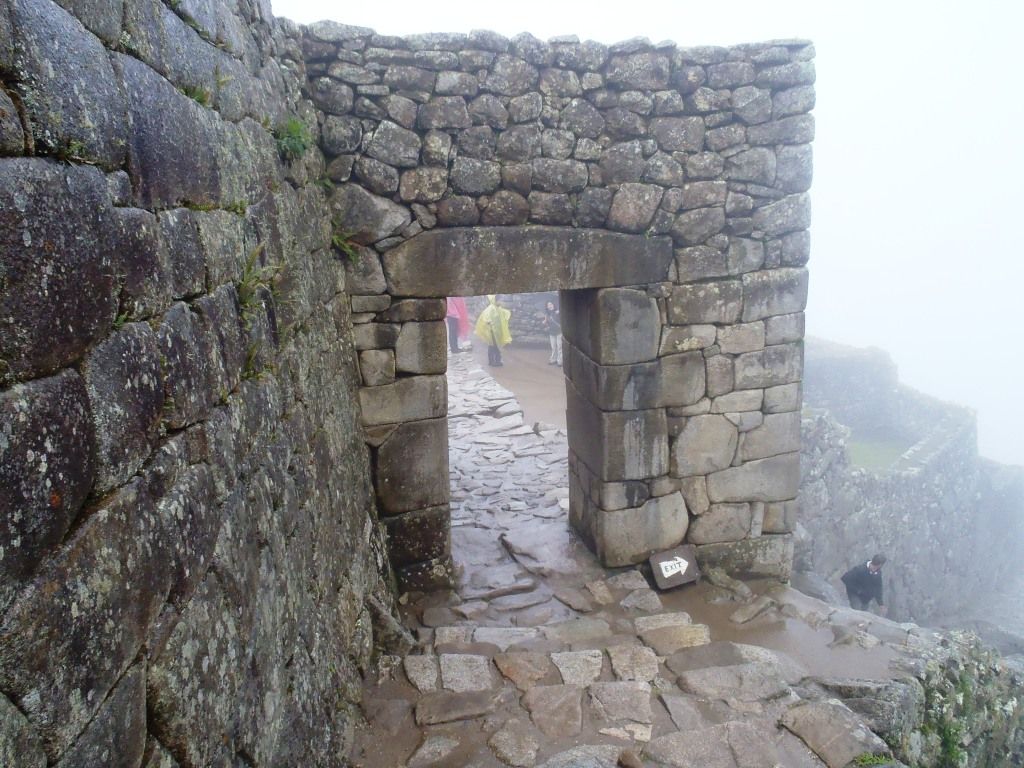
Our guide then showed us an unfinished portion of the city where the rocks had been only partially quarried:
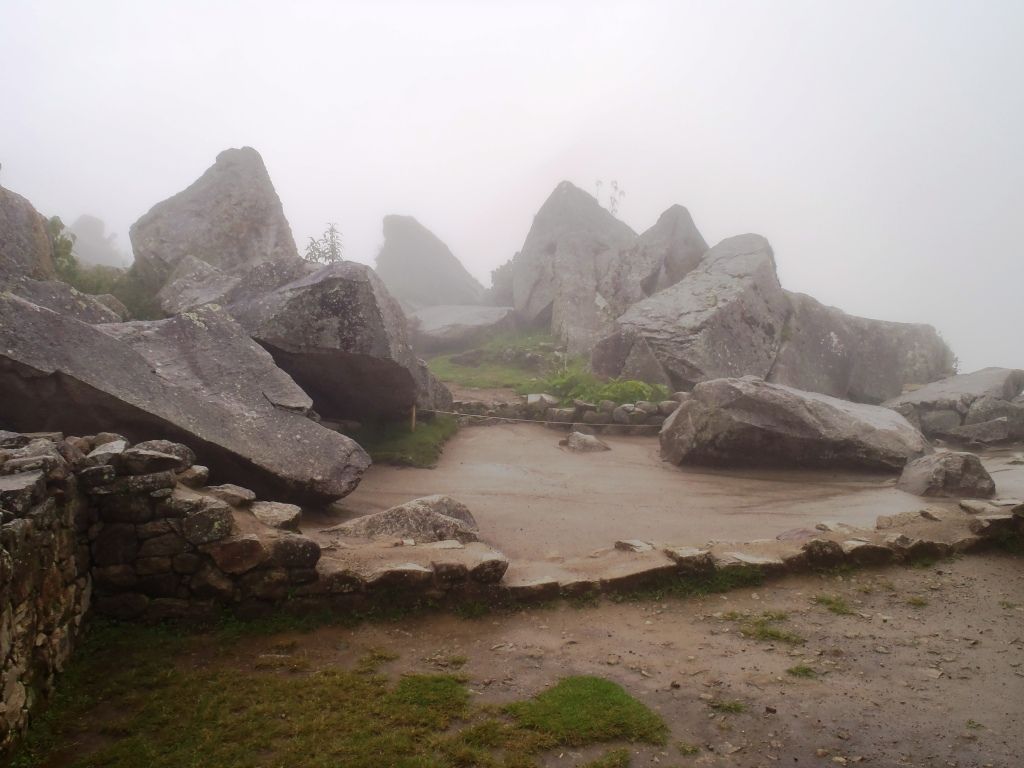
Those massive stones are what were used to build Machu Picchu. Much of the splitting of the rocks was accomplished using fire and water, wooden wedges, or hematite chisels (a mostly metallic rock that is extremely hard):

It was incredible to see how many of the buildings were integrated with the large boulders that dotted the landscape of the ruins:
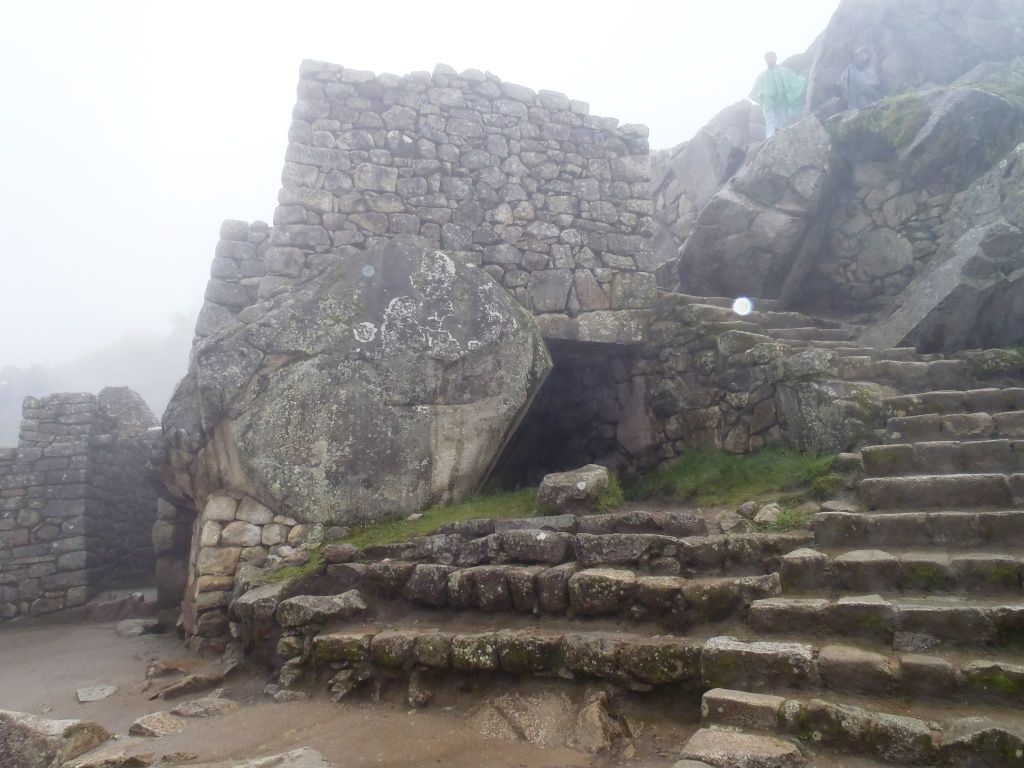
At this point, the weather began to clear a little more and we were able to get a better view of the ruins:

Our next stop was at the Temple of the Sun:

...and then a rock in the shape of the Southern Cross that is believed to be a primitive type of compass:
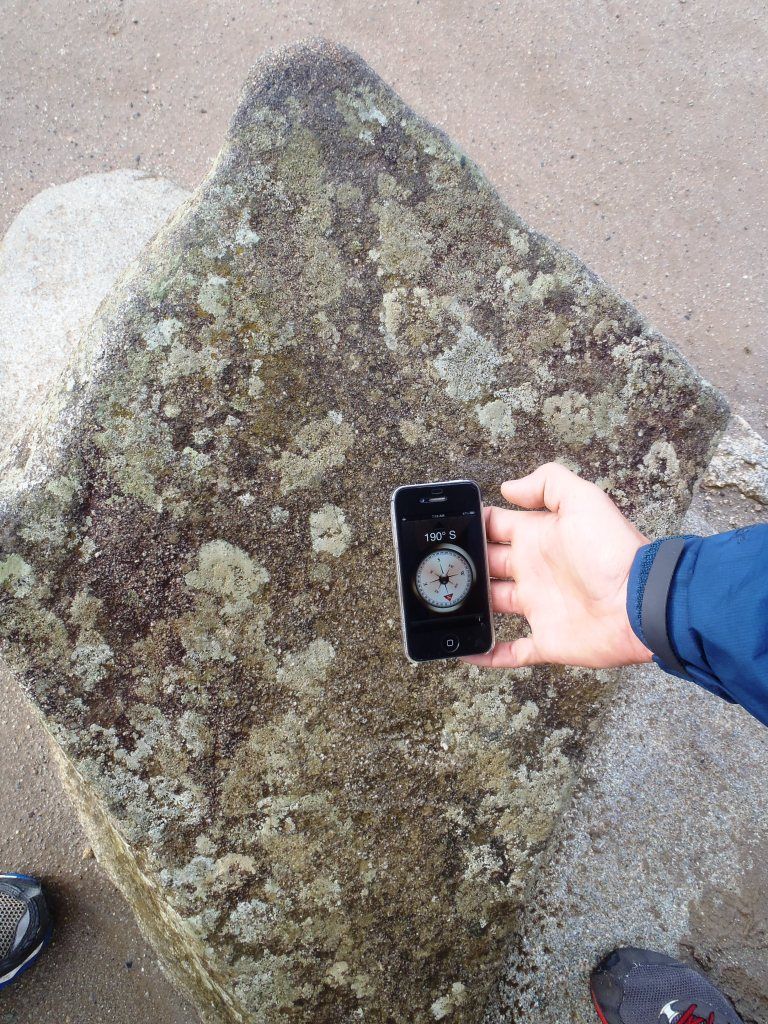
....and then the Hitching Post of the Sun:
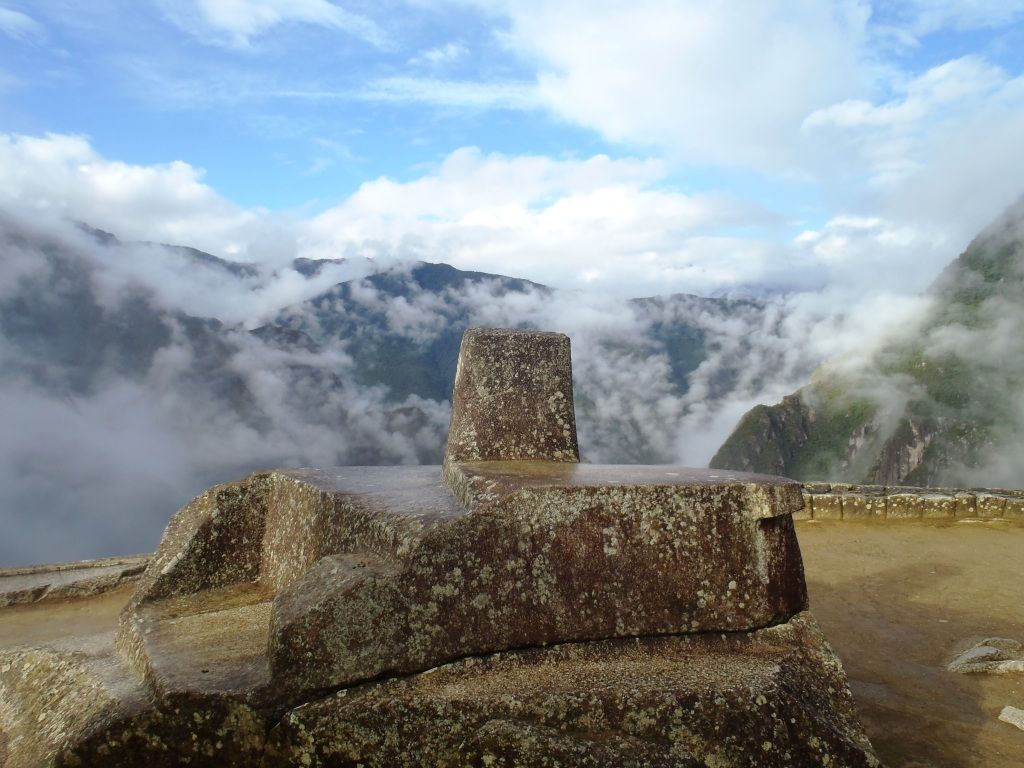
......followed by more incredible views of the ruins and surrounding countryside:
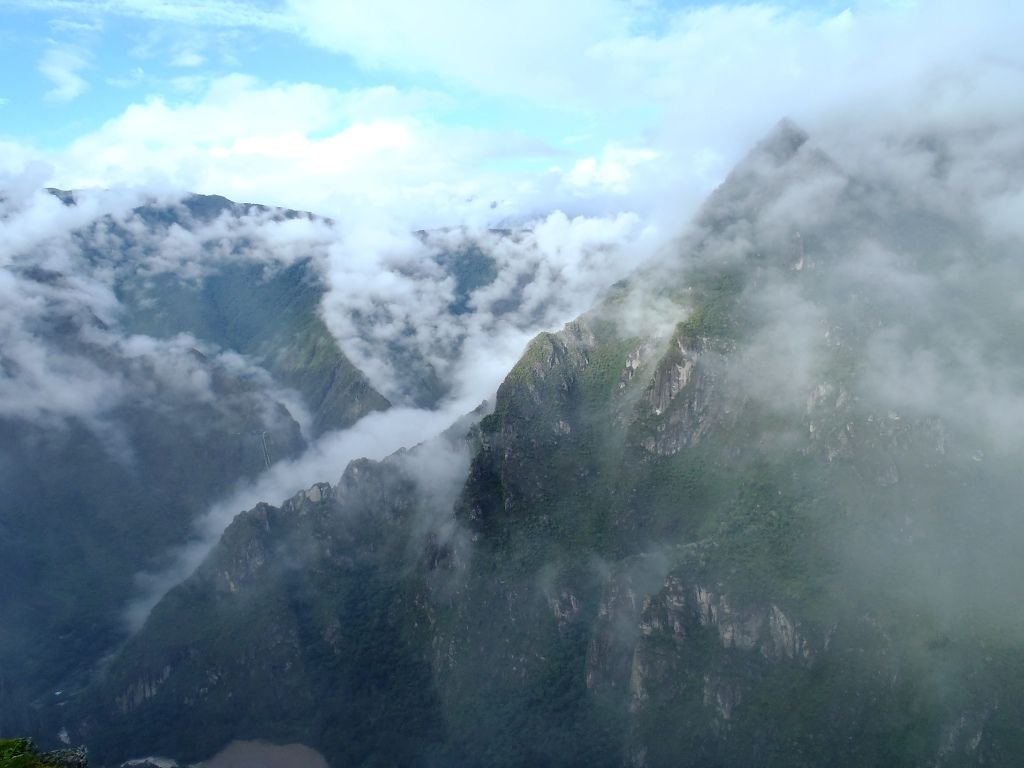
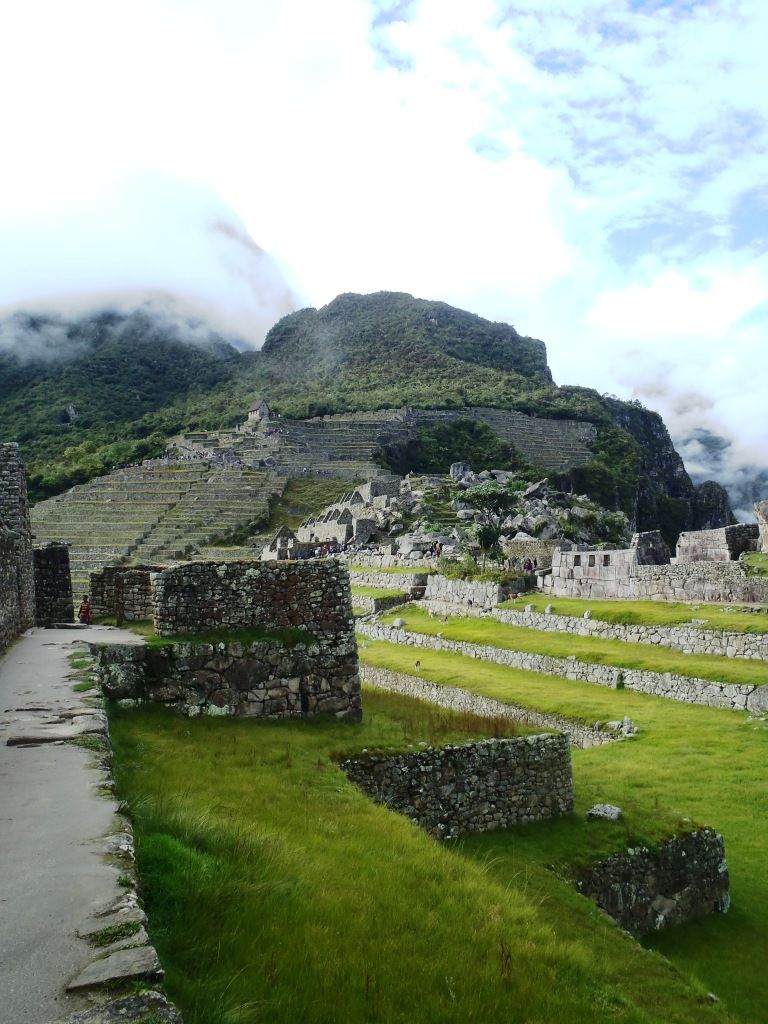
Check out the llamas grazing in the main plaza:
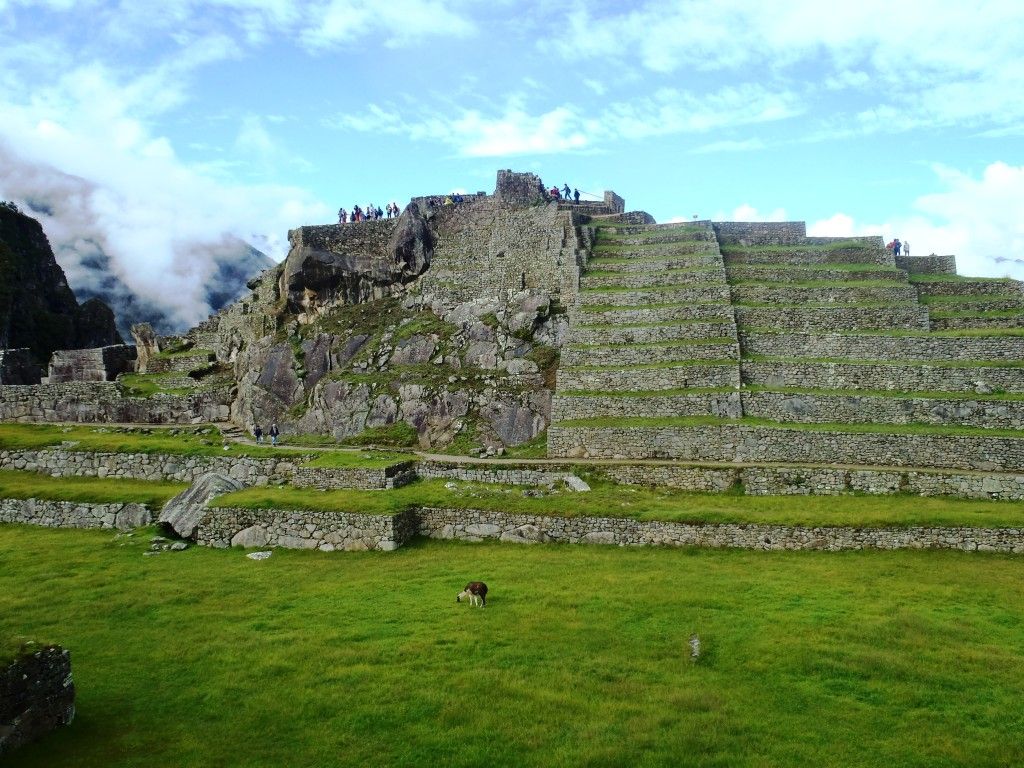
This is the main aqueduct that supplied water for the city:
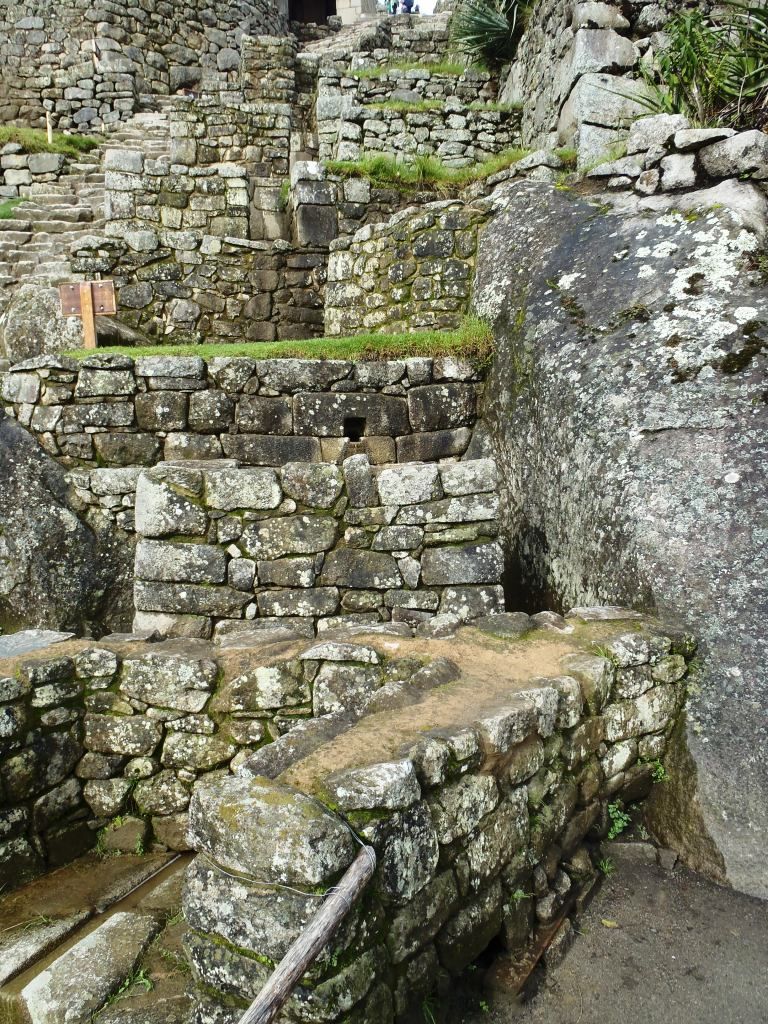
Towards the end of the tour, the light began to improve and we were treated to some incredible scenes:


We finished up the tour right as the first big batch of tourists swamped in along one of the terraces:

By the way, the terraces that all of those people are standing on were used for agriculture. The Incans used "flying stairs" in their terraces to maximize space for crops:

Soon, the unrelenting hoards were swarming into the ruins and I decided that it would be a good time to get to some higher ground and take some better pictures.
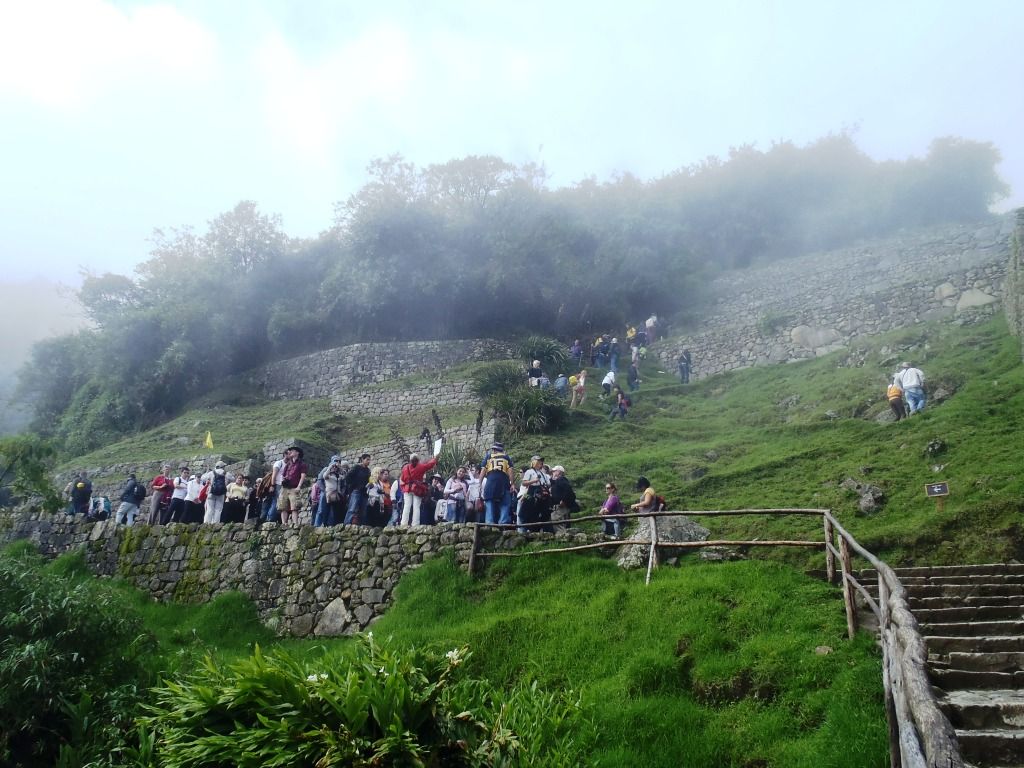
Luckily, right as I topped out at where we had started our tour, the sun came out and I was treated to a gorgeous view of Machu Picchu:
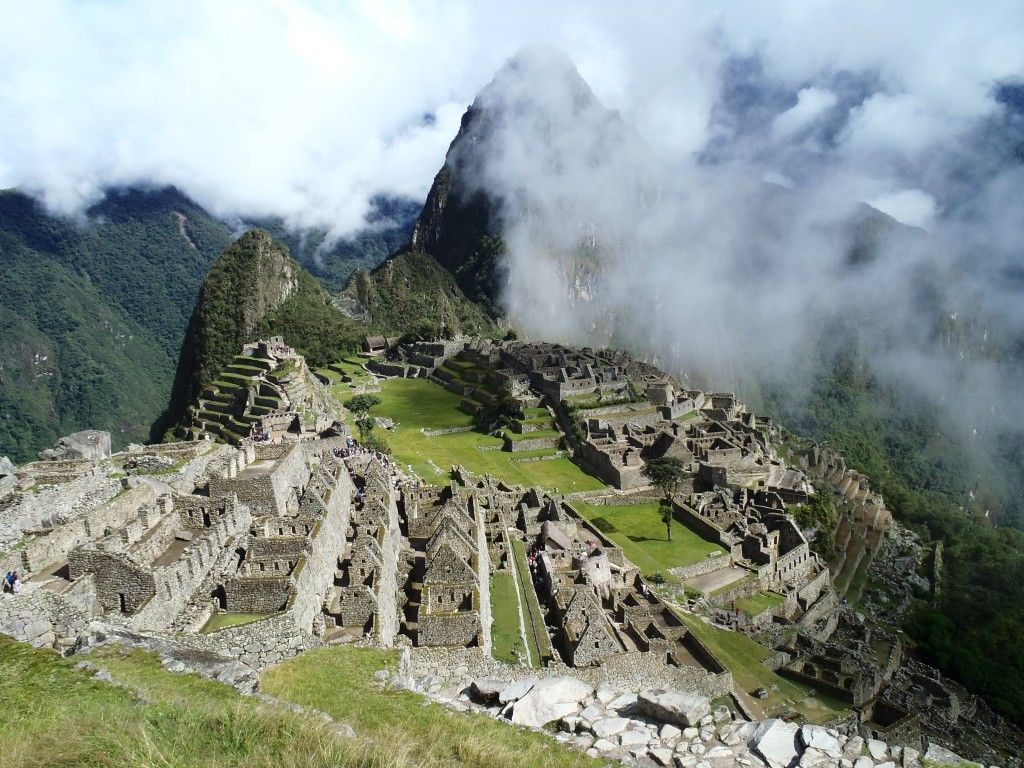
I couldn't resist, I had to get another portrait of myself with the ruins:

That tall, imposing hunk of rock above and to the right of my head is Wayna Picchu. There are actually ruins up there as well; however, as I said earlier, we weren't able to get tickets. Fortunately, we had been able to get tickets to Machu Picchu Mountain which lies to the south of the city and is even higher and more difficult to get to than Wayna Picchu; i.e., less people go up there.
I started moving towards the trail to the summit of the mountain and stopped to take a few pictures along the way:
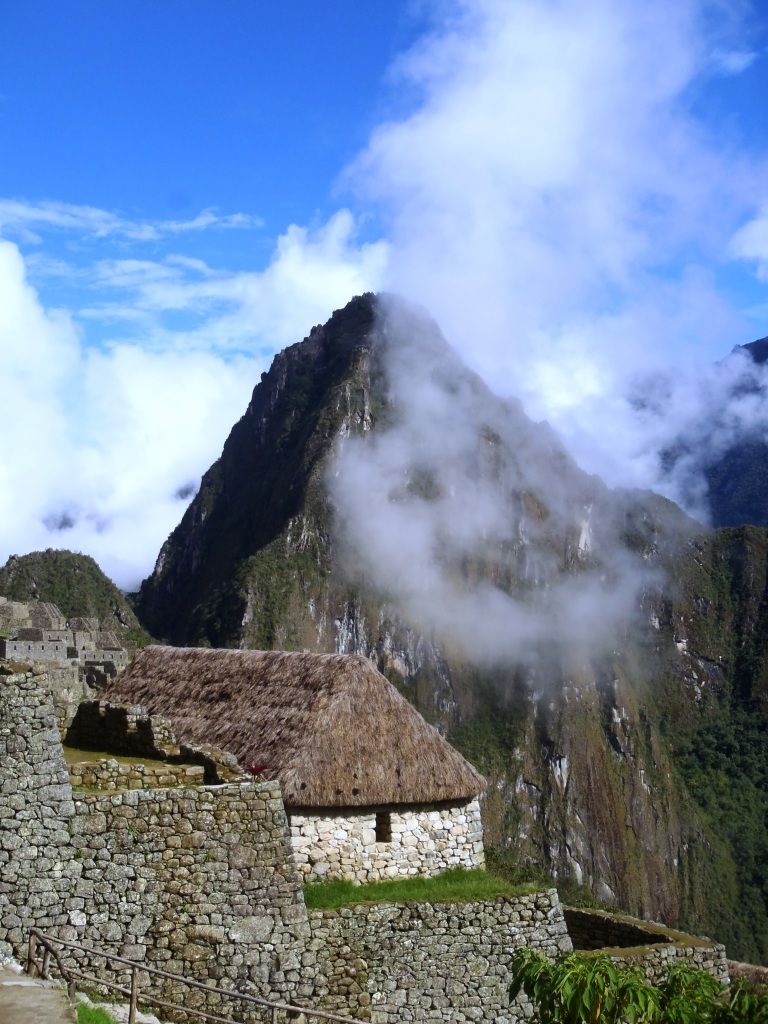


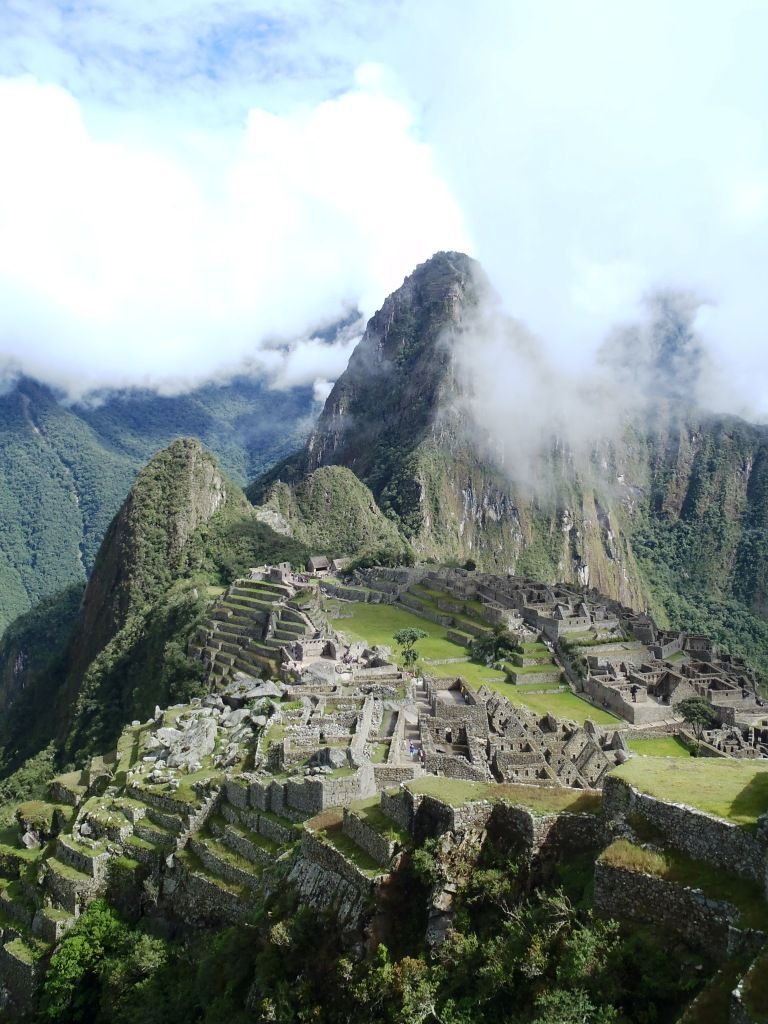
The trail to the top of the mountain consisted of a massive flagstone staircase that climbed and climbed for what seemed like thousands of feet. I soon named it the "Stairmaster From Hell".

Still, I was able to maintain a slow but steady pace, and made it to the top in about an hour.

At the top, I was treated to amazing views of the ruins and the nearby river.


I hung out at the top and talked with some Argentinians and a few Americans. I ended up staying at the summit for about an hour until the weather started moving in and I decided to make a break back down the trail. The "Stairmaster From Hell" soon became the "Slippery Stairmaster From Hell". Still, I managed to jog back down to the bottom without killing myself.

By the time I reached the bottom the rain was coming down hard again and it was time to leave Machu Picchu. Mike and I sprang for a bus rather than walking down in the rain and rode back to Agua Calientes. It was too late to catch a train back to Hidroelectrica, so we got a new hotel room and went for a soak in the local hot springs.
In summary, here's the good, the bad, and the ugly of Machu Picchu:
The Good: It's one of the most iconic archaeological sites in the world. And it's just stunningly beautiful. The craftsmanship is incredible, the location superb, and the aesthetics impeccable. When the mist cleared up and we were able to see the entire city with Wayna Picchu in the back ground for the first time, I was blown away. With a decent tour guide that speaks your language fairly well, you will be astounded at what you learn about the city. It's just about one of the coolest things I've ever seen, despite what you are about to read below......
The Bad: Expensive!!! Peru knows that everyone in the world wants to come here, and they can charge prices that will make your head spin. It's not like people are going to stop coming to Machu Picchu. A $140 round trip train ride to and from Cusco? Give me a break. I also learned that to hike the Inca Trail into Machu Picchu (a four day affair) requires a certified guide and can cost anywhere from $500 to $1,000! It's a total tourist trap. Even doing it the (kind of) cheap way like we did is expensive.
The Ugly: Aguas Calientes, the gateway into Machu Picchu, is a town build for one thing only: tourism. It's packed with wall to wall gringos and there are tons of pushers and touts standing in front of their businesses pestering you to eat at their restaurant, take a picture of their llama, or get a massage. Furthermore, as there is really only one way in and out of the city, they have a captive demographic from which they can charge outrageous prices and give horrible service. A few hotel owners blatantly lied to us about having hot water, wifi, and functioning bathrooms with toilet seats. When we called them out on it, they just shrugged their heads and went back about their business. They just don't care. There are so many people coming through this place that they can pretty much run their business however they want and still make a ton of money.
---------------------------------------------------------------------------------------------------------------------------------------------------------
Here's a bit of info for those of you that may be wanting to do this trip or those of you how just want to visualize where the places are that I'm talking about. Below is a little panoramic view of the the route in from Santa Theressa:

From Santa Theressa you can either ride, walk, or take a taxi or minibus to Hidroelectrica. You can leave your bike at Hidroelecrica behind a shed, or you can park it in the lobby of the Yakamama Hostel for 10 Soles a night. From Hidroelectrica, you can either walk (free) or take the train ($18, $12 return) for the 20 kilometers into Agua Caliente. Once in Agua Caliente, you can walk to Machu Picchu (free) or take the bus ($18.50).
Another piece of advice, if you want to climb Wayna Picchu, you should try and reserve it at least 10 days in advance.
Below is the rough route from Cusco to Santa Theresa. There is good signage and Google maps will give you good directions. See my previous day's post for a rough description of the route with some pictures. You can also get a good diagram/paper map and advice from the guys at Peru Moto Tours (bike rental shop) in Cusco.
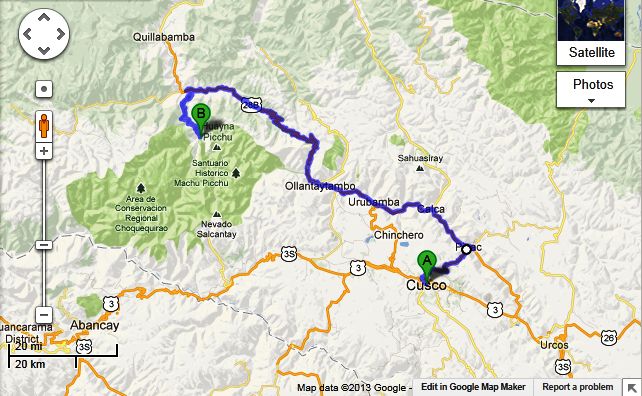
Hope this helps!
Aguas Caliente, Peru to Machu Picchu, Peru
Day's Bus Ride: 5 Miles
We woke up at 4:30 AM to the sound of rain. That is not a good way to start off a visit to Machu Picchu. Actually, Mike was out the door by 4:30; I got up and took my time. By the time I arrived at the bus station, Mike was standing there first in line drinking coffee. It pays to have somebody who's willing to take one for the team!
From Aguas Calientes, there are two ways to get to the top of the hill to see the ruins: walk or take a bus. Initially we had been planning on hiking so that we could be up at the gate when the ruins opened and hopefully snag an entrance ticket to Wayna Picchu, the steep mountain overlooking the north side of Machu Picchu. Unfortunately, we found out last night that the entrance tickets to Waynu Picchu are now sold in advance and there weren't any available for the next week or so. Thanks for nothing Lonely Planet.
In any event, since we weren't in any hurry to get into Wayna Picchu, we took the first bus at 5:30 AM and were at the gates when they opened at 6:00 AM. Unfortunately, it was still foggy and raining hard. We splurged and hired a "guia" (guide) for 60 Soles each and then entered the park. We soon emerged above the ruins and beheld this:

Everything was totally socked in! It was very disappointing, especially after spending so much time and money (despite doing it the cheaper way) to get to this point. Our guide reassured us that the rain would stop soon, and he was right. Little by little, the fog began to clear and the rain began to abate.
Not knowing if the weather might move back in before we got another chance to get pictures, I got my Machu Picchu picture in at the iconic overlook.

The one really nice thing about the rain was that it drove most of the tourists away and for the first part of our tour, we had the place mostly to ourselves.
Leaving the overlook, we descended into the city by the southern gate.

Our guide then showed us an unfinished portion of the city where the rocks had been only partially quarried:

Those massive stones are what were used to build Machu Picchu. Much of the splitting of the rocks was accomplished using fire and water, wooden wedges, or hematite chisels (a mostly metallic rock that is extremely hard):

It was incredible to see how many of the buildings were integrated with the large boulders that dotted the landscape of the ruins:

At this point, the weather began to clear a little more and we were able to get a better view of the ruins:

Our next stop was at the Temple of the Sun:

...and then a rock in the shape of the Southern Cross that is believed to be a primitive type of compass:

....and then the Hitching Post of the Sun:

......followed by more incredible views of the ruins and surrounding countryside:


Check out the llamas grazing in the main plaza:

This is the main aqueduct that supplied water for the city:

Towards the end of the tour, the light began to improve and we were treated to some incredible scenes:


We finished up the tour right as the first big batch of tourists swamped in along one of the terraces:

By the way, the terraces that all of those people are standing on were used for agriculture. The Incans used "flying stairs" in their terraces to maximize space for crops:

Soon, the unrelenting hoards were swarming into the ruins and I decided that it would be a good time to get to some higher ground and take some better pictures.

Luckily, right as I topped out at where we had started our tour, the sun came out and I was treated to a gorgeous view of Machu Picchu:

I couldn't resist, I had to get another portrait of myself with the ruins:

That tall, imposing hunk of rock above and to the right of my head is Wayna Picchu. There are actually ruins up there as well; however, as I said earlier, we weren't able to get tickets. Fortunately, we had been able to get tickets to Machu Picchu Mountain which lies to the south of the city and is even higher and more difficult to get to than Wayna Picchu; i.e., less people go up there.
I started moving towards the trail to the summit of the mountain and stopped to take a few pictures along the way:




The trail to the top of the mountain consisted of a massive flagstone staircase that climbed and climbed for what seemed like thousands of feet. I soon named it the "Stairmaster From Hell".

Still, I was able to maintain a slow but steady pace, and made it to the top in about an hour.

At the top, I was treated to amazing views of the ruins and the nearby river.


I hung out at the top and talked with some Argentinians and a few Americans. I ended up staying at the summit for about an hour until the weather started moving in and I decided to make a break back down the trail. The "Stairmaster From Hell" soon became the "Slippery Stairmaster From Hell". Still, I managed to jog back down to the bottom without killing myself.

By the time I reached the bottom the rain was coming down hard again and it was time to leave Machu Picchu. Mike and I sprang for a bus rather than walking down in the rain and rode back to Agua Calientes. It was too late to catch a train back to Hidroelectrica, so we got a new hotel room and went for a soak in the local hot springs.
In summary, here's the good, the bad, and the ugly of Machu Picchu:
The Good: It's one of the most iconic archaeological sites in the world. And it's just stunningly beautiful. The craftsmanship is incredible, the location superb, and the aesthetics impeccable. When the mist cleared up and we were able to see the entire city with Wayna Picchu in the back ground for the first time, I was blown away. With a decent tour guide that speaks your language fairly well, you will be astounded at what you learn about the city. It's just about one of the coolest things I've ever seen, despite what you are about to read below......
The Bad: Expensive!!! Peru knows that everyone in the world wants to come here, and they can charge prices that will make your head spin. It's not like people are going to stop coming to Machu Picchu. A $140 round trip train ride to and from Cusco? Give me a break. I also learned that to hike the Inca Trail into Machu Picchu (a four day affair) requires a certified guide and can cost anywhere from $500 to $1,000! It's a total tourist trap. Even doing it the (kind of) cheap way like we did is expensive.
The Ugly: Aguas Calientes, the gateway into Machu Picchu, is a town build for one thing only: tourism. It's packed with wall to wall gringos and there are tons of pushers and touts standing in front of their businesses pestering you to eat at their restaurant, take a picture of their llama, or get a massage. Furthermore, as there is really only one way in and out of the city, they have a captive demographic from which they can charge outrageous prices and give horrible service. A few hotel owners blatantly lied to us about having hot water, wifi, and functioning bathrooms with toilet seats. When we called them out on it, they just shrugged their heads and went back about their business. They just don't care. There are so many people coming through this place that they can pretty much run their business however they want and still make a ton of money.
---------------------------------------------------------------------------------------------------------------------------------------------------------
Here's a bit of info for those of you that may be wanting to do this trip or those of you how just want to visualize where the places are that I'm talking about. Below is a little panoramic view of the the route in from Santa Theressa:

From Santa Theressa you can either ride, walk, or take a taxi or minibus to Hidroelectrica. You can leave your bike at Hidroelecrica behind a shed, or you can park it in the lobby of the Yakamama Hostel for 10 Soles a night. From Hidroelectrica, you can either walk (free) or take the train ($18, $12 return) for the 20 kilometers into Agua Caliente. Once in Agua Caliente, you can walk to Machu Picchu (free) or take the bus ($18.50).
Another piece of advice, if you want to climb Wayna Picchu, you should try and reserve it at least 10 days in advance.
Below is the rough route from Cusco to Santa Theresa. There is good signage and Google maps will give you good directions. See my previous day's post for a rough description of the route with some pictures. You can also get a good diagram/paper map and advice from the guys at Peru Moto Tours (bike rental shop) in Cusco.

Hope this helps!
No comments:
Post a Comment